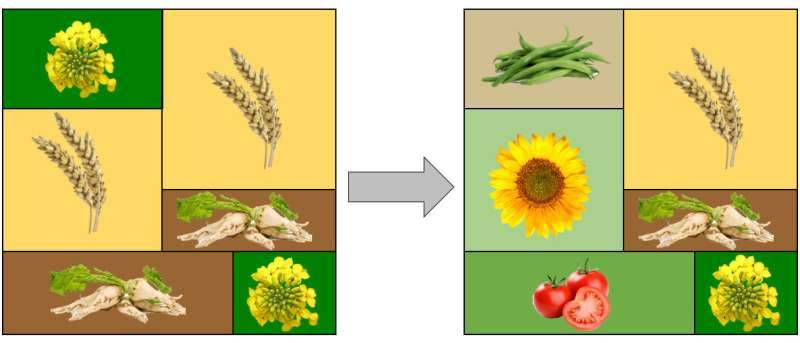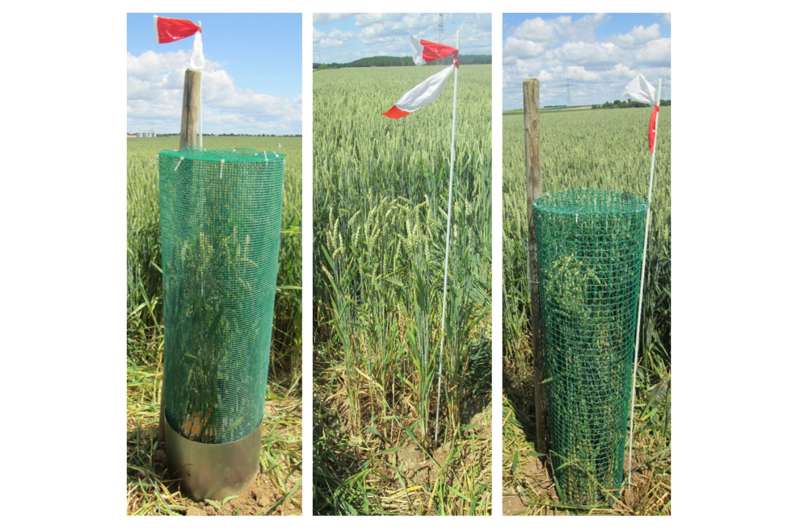Natural aphid predators reduce pesticide use

The greater the diversity of crops grown in agricultural landscapes is, the better natural predators of aphids are able to control the pests on wheat fields. This is because a varied landscape provides better living conditions for aphids' natural predators than a never-ending series of monocultures.
Where wheat is grown on huge areas, ladybirds, spiders, hoverfly larvae and other predators of aphids don't have enough food in spring, as aphids begin to populate the wheat fields later, when they start to reproduce. Therefore, their predators migrate to areas with a more abundant supply of food. The aphids thus encounter ideal conditions, since their predators are low in numbers.
The situation looks different if a variety of crops is cultivated around a wheat field. This effect is all the more pronounced in landscapes of higher diversity in a 500-meter radius around the field, according to Sarah Redlich, who has published her results in the Journal of Applied Ecology; she is an ecologist and a Ph.D. student of Professor Ingolf Steffan-Dewenter at the University of Würzburg in Bavaria, Germany.
18 landscapes around Würzburg investigated
For her study, the scientist picked 18 landscapes in the greater Würzburg area that exhibited a maximum crop diversity. The landscapes were six kilometres in diameter and each had a winter wheat field at its centre. "We chose fields in low-diversity landscapes and fields with high landscape-level crop diversity," Sarah Redlich explains. For this purpose, the abundance and area of up to 12 crop plant groups in the landscape were calculated, both in a small radius (up to 500 metres) and in a larger radius (3000 metres) around the fields.

She set up two cages each containing 100 aphids on each winter wheat field. The wheat in one of the cages was completely inaccessible. "This cage was designed to keep out all predators. I wanted to know how quickly the aphids reproduce in this case," Redlich says.
The other cage was coarse-meshed, denying access by birds, while allowing smaller predators. "I used this set-up to determine the influence birds have on regulating the aphid population in wheat," the scientist explains.
Thirdly, she demarcated an area that was fully accessible to all predators and again put out 100 aphids there. "I let nature take its course, here," Redlich explains. She then counted the aphids and their predators at five-day intervals for around two weeks. After this time, she compared the aphids' population development in the environments with predators to that in predator-free cages. She found that the more varied the landscape around the wheat field is, the fewer aphids thrive on the wheat plants. And what is more, birds proved to be irrelevant as natural predators of aphids on wheat in the crop system under investigation.
Benefit for farmers
Farmers can also capitalize on this finding: "If they cultivate their fields accordingly, namely increase crop diversity, they may be able to cut down on pesticides which after all damage the natural predators, too," the ecologist says. "The fact that the biggest impact of crop diversity was found in a radius of 500 metres around the fields adds further advantages. Often, the adjacent fields are owned by the farmers, leaving them free to decide for themselves which crops to grow there. Within the three-kilometre radius, they would have to agree with their neighbours which crops to grow, which would be more difficult but still feasible," says Redlich. Moreover, the finding could help the farmers implement a regulation of the EU Common Agricultural Policy that has been in force since 2014. It stipulates that a greater crop diversity must be grown within the scope of "greening" efforts. This means that farmers need to cultivate "plants that are more diverse in terms of structure and food availability," says Sarah Redlich. This would require the farmers to create fields of sunflower, rapeseed, beet or similar crops around a field of winter wheat to establish a mix of plants in the landscape that sustains as many predators of aphids or other pests as possible throughout the year.
More information: Sarah Redlich et al, Landscape-level crop diversity benefits biological pest control, Journal of Applied Ecology (2018). DOI: 10.1111/1365-2664.13126
Journal information: Journal of Applied Ecology
Provided by University of Würzburg


















